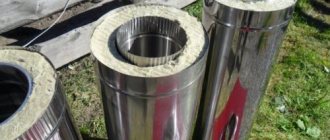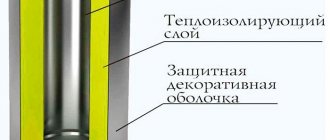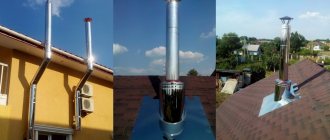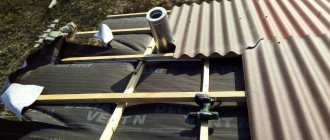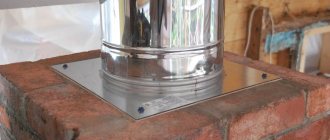Peculiarities
The unique chimney device consists of three parts:
- inner pipe made of stainless steel with excellent strength and heat resistance;
- thermal insulation material in the form of basalt or ceramic wool, polyurethane foam, vermiculite.
- protective outer pipe made of galvanized/stainless steel.
To improve aerodynamics, the designers provided a cylinder shape. All three layers of a stainless steel sandwich pipe are glued together, and some parts of the chimney are mounted, as in drainage pipes, with sockets.
Pros and cons of using chimneys
*
Ease of construction and low weight allow you to install smoke removal systems in any home. Since the choice of a chimney is a very important part of the development, you need to carefully study all aspects before its completion. Sandwich pipes used in chimney installation have pros and cons:
- During the smoke removal process, only the internal part is significantly heated. The outer pipe remains cold or moderately warm due to the stone wool insulation. This reduces the possibility of burns and fires.
- Rapid heating of the insulated pipe increases draft.
- Soot settles less often on a smooth steel surface than on a brick or ceramic surface. Ease of smoke removal does not contribute to the accumulation of condensate; combustion products do not react with water.
- Multilayering provides protective functions. The outer layer protects the inner pipe from mechanical damage, and itself is insulated from high temperatures.
- Slight condensation may form on the outer pipe.
- The weight of the chimney is much lighter than a brick one; installation is possible without an additional foundation.
The disadvantage is the possibility of partial depressurization of the seams after about 10 years of operation.
Sandwich chimney brought out through the wall with a fixing brace on the roof
Advantageous use of double pipes
What is the advantage of using such products for chimney devices? First of all, in:
- Ease of installation.
The right approach and competent study of the main nuances will help you install a sandwich chimney yourself.
- Small mass.
Thanks to this characteristic, a separate foundation for the furnace is not required.
- Compactness, which, combined with ease, allows you to easily transport products to your destination.
- A simple repair, thanks to which specialists can easily replace one of its parts in the chimney.
- A variety of shaped parts that will help install the device with an exit through the roof or wall.
- The presence of a heat-insulating layer between the pipes, which allows reducing the temperature from the outside.
This advantage is aimed at improving the fire safety of the structure.
- The absence of stagnation and the possibility of effective smoke removal, because the inner surface of the pipe has a smooth cylinder shape.
This is why so little soot is formed in stainless steel sandwich chimney pipes.
- Anti-corrosion materials from which the products are made, so condensation and destructive chemical compounds do not accumulate on the walls of the latter.
- Ease of operation. Regular preventive inspections of chimneys are, of course, necessary, but the design nuances of such products make it possible to perform them not so often.
- Attractive appearance. Sandwich pipes do not require additional finishing, and they look great both outside and indoors.
Relevance of the design
Every heat source that uses the energy of burning fuel is burdened with two serious problems:
- fire hazard;
- thermal expansion.
Thus, the created channel should transfer the minimum possible amount of heat to the outer surface. The degree of thermal expansion of the structure should also be minimized. The construction of a chimney from sandwich pipes for a bathhouse fully realizes both of these requirements, so the use of such products is very reasonable. But its advantages are not limited to this: the building acquires an aesthetic appearance without sacrificing functionality. In addition, the ease of installation allows you not to involve outside specialists.
Note! The name “sandwich pipe” is associated solely with the design features of the product. It consists of two segments inserted into one another, on the inner surface of which a layer of special heat-insulating material is applied - mineral wool or basalt fiber.
A sandwich is a double-walled insulated pipe, most often made of stainless steel
Double-walled chimneys are produced in many designs. They differ in pipe material, type and thickness of insulator, diameters, etc.
Stainless steel: design nuances
This material is quite resistant to temperature changes and is endowed with excellent anti-corrosion qualities. Internal stainless steel products can withstand temperatures of +850°C and even temperature changes of up to +1200°C.
In the production of sandwich pipes, two grades of steel are most often in demand: 310S and 316 Ti. The temperatures of the working media for these materials are quite high, the maximum threshold reaches +1000 C. These two grades of stainless steel are especially preferable in chimney structures for bathhouses and solid fuel boilers, where it is necessary to withstand very high temperatures. Such chimney products will last a very long time.
If you are interested in a high-strength design, then the ideal option would be to make the inner and outer shell of the pipe from one stainless steel.
The thickness of the thermal insulation layer affects the cross-sectional dimensions of the pipe. In addition, the diameter of the sandwich pipe for the chimney depends on the location of the device. Depending on the power of the heating device, internal pipes are selected. The larger it is, the larger the cross-sectional size of the product should be. This direct dependence appeared for a reason, since the inner stainless steel pipe takes on the main temperature shock during operation.
Here are the main indicators of the relationship between the pipe diameter and the power of the furnace structure:
- product cross-section 50-600 mm - for gas turbine units and wood-burning stoves;
- diameter 50-700 mm - for solid fuel boilers;
- 50-500 mm - for diesel generators and gas piston devices;
- 50-300 mm - for microturbine devices;
- up to 200 mm - for gas or diesel fuel boilers.
We must not forget that it is not recommended to use fiberglass as a thermal insulation layer, because it retains its performance characteristics only at a temperature not exceeding +350̊ C. And in structures for baths, this figure reaches +600̊ C.
Calculation procedure
To determine the diameter of the sandwich pipe, it is necessary to know in advance the conditions under which the operation will be carried out. Based on the size of the area of the heated room, a stove suitable for productivity is selected. To heat 10 sq.m. 1 kW of power is needed, respectively, for a room of 50 sq. meters, a 5 kW oven is suitable.
The temperature of the exhaust smoke depends on the type of heating boiler and the fuel used. The more degrees in the chimney, the more it heats up. The table clearly shows the relationship between temperature height and type of heating device.
Smoke temperature in different boilers:
| Type of heating boiler | temperature , C |
| Stove-fireplace | 350-650 |
| Sauna stove | 400-700 |
| Pyrolysis boiler | 160-250 |
| Pellet boiler | 120-250 |
| A gas boiler | 120-200 |
| Diesel boiler | 150-250 |
| Coal boiler | 500-700 |
*
In a sandwich chimney, the inner pipe heats up the most, so first of all, choose its diameter. The more powerful the oven, the wider it should be. As power increases, the internal hole must also increase. The power calculation can be seen in the table:
Average values of the ratio of boiler power and chimney cross-section:
| Boiler power, kW | Chimney cross-section, mm | S output diameter, sq. mm | Pipe diameter |
| less than 3.5 | 140 x 140 | 19 600 | 158 |
| 3,5 – 5,2 | 140 x 200 | 28 000 | 189 |
| 5,2 — 7 | 140 x 270 | 37 800 | 220 |
For open fireboxes, the smoke channel must exceed 1/100 of the boiler volume. In closed boilers, where air enters the firebox from the lower ash pan, the internal area of the chimney outlet must exceed the size of the supply opening. If the diameter exceeds the calculated one by one and a half times or more, then the traction force drops, and vortices form inside the chimney.
The arrangement of layers in sandwiches allows you to isolate the outer pipe from high temperatures, technical characteristics prevent the formation of condensation. Stone wool is non-flammable, its thickness depends on the temperature of the exhaust fumes from 25 mm at 60 C to 100 mm at 600 C.
Types of sandwich pipes
In addition to stainless steel and galvanized steel, other materials are used to produce sandwich pipes for chimney structures. For example, ferrous metals are also in demand, but they are then coated with a protective layer of enamel. Such products can withstand operating temperatures up to +500̊ C and temperature changes up to +750̊ C. Read also: “Types of galvanized chimney pipes, their advantages and installation rules.”
By the way, finished stainless steel sandwich pipes are resistant to the destructive effects of corrosion and look quite presentable. If we talk about their resistance to high temperatures, they are significantly inferior to stainless steel devices. But, at the same time, chimneys made of ferrous metals are in demand in the production of fireplaces and stoves. This chimney is easy to install, durable and practical to maintain.
Another type of sandwich is a combined structure made of galvanized steel (enamel-coated) and stainless steel. Such chimneys can withstand temperatures of a maximum of 600°C.
Chimneys with ceramic walls
A logical continuation of the technological development of sandwiches was the use of new material. Such innovations involve the use of particularly heat-resistant ceramics for internal pipes instead of stainless steel.
A striking example is the sandwiches of the German company Schiedel:
- the internal channel is made of high-quality and heat-resistant ceramics;
- outer layer made of reliable stainless steel;
- 60 cm insulation is made of compacted basalt wool.
The manufacturer includes in the kit all the necessary elements and shaped parts from which you can build a structure of any shape. The use of highly resistant sealant to fasten the elements makes assembly easy and reliable in the area of the joints.
Ceramic is an excellent sandwich material that exhibits high resistance to combustion products at high temperatures. If assembled correctly, such a system will last more than 30 years. Heat resistance allows you to mount ceramic sandwiches on any boilers (gas, solid fuel, liquid fuel).
Pipe insulation: main characteristics
Between the two pipes of the chimney structure (external and internal) there is material for thermal insulation. Basically, this is mineral wool (basalt or ceramic).
Sometimes the natural material vermiculite acts as insulation. To use it for its intended purpose, it is first crushed to a granular state and then fired in a special oven.
Such procedures are necessary to obtain the highest quality characteristics:
- resistance to high temperatures and temperature changes;
- low weight;
- strength, etc.
Vermiculite is much more expensive than mineral wool, but it is distinguished by the ability to maintain its quality characteristics at a chimney operating temperature of +1150̊ C.
The most popular option for mineral material for thermal insulation is basalt wool, which is extracted from molten basalt. This insulation can be used in a chimney structure operating at temperatures up to +600̊ C. A pipe with such a warm layer can be purchased at a reasonable price.
But ceramic wool is more heat-resistant and can withstand operating temperatures of +1260̊ C, i.e. more than twice that of the previous material. Accordingly, the price of sandwiches with such a filler will be higher than pipes with basalt wool or vermiculite.
Main dimensions of pipe products
It is important to remember that the dimensions of the sandwich pipe for the chimney depend on the diameter of the boiler pipe outlet. During installation, the product is mounted on it, so the cross-section of the sandwich pipe must necessarily exceed the outlet pipe.
Today, chimney sandwiches with a cross-sectional size of 0.5 and 1 m are more in demand, but they also come with diameters ranging from 110-300 mm. In the range of pipe sizes for chimney structures, there are other options, but much less frequently.
Pipe connecting elements have angles:
- 90°C - for corners and tees;
- 135̊ C - only for tees.
The thickness of the inner wall is 0.5-1 mm, and the outer wall is 0.7 mm. The thickness of the internal thermal insulation layer ranges from 2.5-6 cm, and the outer diameter of the sandwich structure is 200-430 mm.
The technical data sheet for the product indicates the diameters of the internal and external pipes in fractions, for example, 110/170 mm.
How to properly install a chimney through the ceiling
A very important and difficult part is the passage of the chimney through the ceiling. First, an opening is made from the inside of the roof. Next, the under-roof sheet, which is made of galvanized steel, is fixed inside, and the roof trim is installed on the outside. After securing the apron, which is welded to the roof groove, the next part of the structure is installed. The lower the pipe is located, the more it should rise above the roof. The chimney can rise above the roof:
- With a distance to the ridge of 150 cm, the dimensions of the pipe above the ridge are 50 cm;
- At a distance of 150-300 cm, the dimensions of the pipe are not lower than the ridge;
- At a distance of more than 300 cm, the dimensions of the pipe are below the ridge to the conventional line, which is drawn at a 10˚ slope to the horizon line.
Docking of chimney elements
Finally, after the required pipe length dimensions have been established, the fungus is attached. Installation of stove heating in a country house is an integral and mandatory part when installing fireplaces, baths, and saunas. Having studied all the subtleties and principles, it is quite possible to install a sandwich chimney with your own hands. And then safety, coziness and comfort are ensured for many years.
Types of connecting elements
The heating device, in addition to sandwich pipes, also includes other shaped parts, for example:
- chimney-convector, which serves to release combustion products outside the building;
- an elbow consisting of several parts that fit together at an appropriate angle. With the help of a knee, you can change the direction of exhaust of combustion products;
- a tee that performs the function of removing condensate and smoke is used very often;
- an adapter that allows the joining of some pipes, the most common element;
- inspection - to clean the structure from soot;
- kagla, regulating traction;
- rosette - for decorating the chimney;
- weather vane and cone protecting the heating system from natural precipitation;
- a fungus made of galvanized steel sheet that protects the chimney structure from snow and rain getting into it. Mounted on the very edge of the outlet pipe.
All these connecting elements can have diameters: 120, 150,200 mm and are used depending on the design features of the chimney device and other factors. The diameter of the inner pipe always corresponds to the size of the sandwich chimney and its additional products.
Important information to note! To extend the operating period of the heating system, you need to use a thicker layer of stainless steel and galvanized sheet to produce the inner and outer pipes in a sandwich device.
Choosing the right chimney
Some factors are important in this matter:
- The quality functioning of the entire sandwich structure is directly dependent on the strength of the material used in its manufacture.
- Sandwich pipe dimensions.
- Density of the thermal insulation layer.
- Type of pipe seam (rolled, laser).
Rolled seams are widely used in gas boilers. Products with laser seams seal the heating system as much as possible and are most often used in solid fuel boilers. Typically, heat-resistant stainless steel is used for the production of internal pipes, but sometimes galvanization is used. This type of sandwich device can be installed in low-power gas boilers.
Placement of a sandwich chimney: recommendations
Installing such a structure is not difficult even for an amateur, but for proper installation you need to know some important rules:
- the height of the chimney in relation to the vertical roof should not be less than 0.5 m;
- when the roof is made of flammable materials, the height of the structure should be greater - from 1 m higher;
- if the distance between the outlet pipe and the roof ridge is 1.5 m, then the height of the chimney should not exceed 0.5 m;
- if this distance is over 3 m, then the height of the chimney is calculated from the following considerations - an imaginary line is drawn at an angle of 10 from the roof ridge to the horizon.
Sandwich pipe service life
The guaranteed service life for different system products varies from 10 to 15 years. This indicator is real only if all requirements for chimney installation are strictly observed: the correct choice of material, seal thickness, etc. Often all these conditions are not met, so the service life is reduced, which ultimately leads to a complete replacement of the chimney after about five years. And it happens like before.
What are the common causes of early structural failure? There are many of them, but often even a factory defect can damage a structure at the very beginning of its operation. Therefore, experts recommend choosing chimney pipes with special care and checking them for defects.
The timeliness of preventive cleaning of the system is of no small importance. Even if the slightest deviation from the norm is detected in the design, operation must be stopped and repair work carried out or a complete replacement of the chimney.
If you follow all the rules when purchasing and operating a sandwich installation, it will serve you for a very long time. Otherwise, an accident may occur with resulting negative consequences. If you doubt your abilities regarding the correct purchase of components and their installation, then it is better to trust the specialists.



